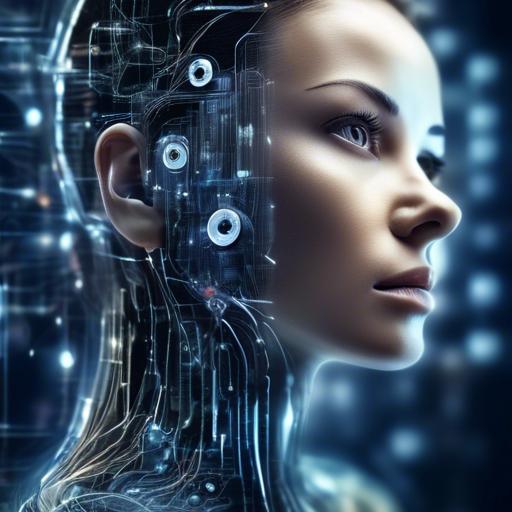Imagine you’re an artist with a blank canvas, brush in hand, ready to create a masterpiece. But instead of painting alone, you have a mysterious partner who challenges every stroke, pushing you to refine your art until it becomes extraordinary. Now, replace the brush and canvas with algorithms and data, and you step into the mesmerizing world of Generative Adversarial Networks, or GANs.
GANs are like the digital artists redefining what’s possible with artificial intelligence—transforming sketches into photorealistic images, generating lifelike human faces, and even creating stunning pieces of digital art. But how do these technological marvels actually work? In this article, we’ll unravel the complexities of GANs with simplicity and clarity, guiding you through the fascinating interplay of two neural networks that dance in a creative duel. Whether you are a curious novice or a tech enthusiast, we’ve got your back. Together, let’s decode the magic behind how GANs create the extraordinary from the ordinary.
Table of Contents
- Understanding the Duality: Generators and Discriminators
- The Magic of Noise: How Random Inputs Create Realistic Outputs
- Training the Juggernaut: A Journey Through Iterative Improvement
- Balancing the Scales: The Art of Equilibrium Between Networks
- Exploring the Latent Space: Unveiling Hidden Patterns
- Evaluating GAN Performance: Metrics and Benchmarks
- Overcoming Challenges: Tackling Mode Collapse and Training Instability
- Practical Tips: Best Practices for Building Your Own GANs
- The Way Forward
Understanding the Duality: Generators and Discriminators
The magic behind Generative Adversarial Networks, or GANs, lies in the interplay between two neural networks: the **Generator** and the **Discriminator**. These two components work together in a dynamic push-and-pull, much like a mentor and a trainee refining a craft.
The **Generator** is tasked with creating data that is as close to real-world samples as possible. Think of it as an artist whose goal is to paint convincing forgeries. It starts off creating rather unrealistic outputs, but with continuous feedback, it learns to produce more lifelike renditions. The Generator’s primary objective is to **’fool’** the Discriminator into thinking that its creations are genuine.
On the flip side, the **Discriminator** acts as the critic. It scrutinizes both real data and the Generator’s synthetic outputs, aiming to distinguish between the two accurately. The Discriminator is essentially a binary classifier that tags input as “real” or “fake.” Over time, as the Generator improves, the Discriminator has to get sharper and more discerning to maintain its edge.
This interaction continues iteratively, each network getting better at its task. The Generator refines its output to bypass the Discriminator’s scrutiny, while the Discriminator hones its ability to detect the increasingly convincing fakes. It’s a dance of deception and detection.
Here’s a quick look at the characteristics of each:
| Aspect | Generator | Discriminator |
|---|---|---|
| Role | Create data | Evaluate data |
| Objective | Fool the Discriminator | Identify genuine/fake data |
| Learning Process | Improves through feedback | Enhances detection skills |
The beauty of GANs is in this duality. The constant tug-of-war between the Generator and the Discriminator leads to the creation of high-fidelity, often stunningly realistic data that would be challenging to produce through conventional means alone. It underscores the power of adversarial learning in pushing the boundaries of what’s possible with artificial intelligence.
The Magic of Noise: How Random Inputs Create Realistic Outputs
Generative Adversarial Networks (GANs) harness the magic of noise, transforming random inputs into lifelike outputs. It might sound paradoxical, but it’s precisely this randomness that gives GANs their creative edge. Imagine starting with a chaotic swirl of white noise — not dissimilar to static on an old television screen — and sculpting it into a coherent, detailed image. This transformation is at the heart of how GANs operate.
**Why does noise matter?**
– **Creativity from chaos:** Randomness prevents the model from becoming too rigid or predictable, enabling it to create diverse outputs.
– **Infinite possibilities:** By starting from noise, GANs can generate an endless array of unique images or data points.
– **Realism through variation:** The randomness ensures the outputs are not mere replicas but are nuanced and varied, mimicking the diversity found in real-world data.
Let’s consider a simple analogy: Think of an artist drawing an intricate scene. If the artist starts with a blank canvas every single time, the scenes might end up being quite similar. However, if they start with a different splatter of paint each time, their creativity is more likely to produce a variety of unique scenes. GANs function similarly, where the “paint splatter” is the initial random noise fed into the system.
Here’s a brief comparison to illustrate the principle:
| Without Noise | With Noise |
|---|---|
| Predictable outputs | Unpredictable and diverse outputs |
| Limited creativity | Boundless creativity |
| High risk of overfitting | Better generalization |
By introducing noise into the generator of a GAN, the resulting data is not only realistic but vibrant and varied. The initial randomness forces the model to learn the distribution of real-world data in a deeper, more nuanced manner. This is why GAN-generated images can sometimes be indistinguishable from actual photographs, creating an almost magical illusion of reality from mere randomness.
Training the Juggernaut: A Journey Through Iterative Improvement
Imagine a formidable duo, constantly pushing each other to new heights. This is exactly how Generative Adversarial Networks (GANs) operate. At its core, a GAN is composed of two neural networks: the **Generator** and the **Discriminator**. These networks engage in a continuous game of one-upmanship, each iteration making them more powerful.
The Generator’s role is to create data that is almost indistinguishable from real data. It’s like an artist trying to paint a masterpiece that can fool an art critic. The Discriminator, on the other hand, acts as the critical art judge, determining whether the data is real or generated. Through this adversarial process, both networks improve iteratively – the Generator gets better at creating realistic data, and the Discriminator becomes sharper at detecting fakes.
- Generator: Creates new data based on feedback from the Discriminator.
- Discriminator: Evaluates data and provides feedback to the Generator.
Every training cycle, known as an **epoch**, the Generator tries to craft better, more realistic outputs. Initially, its attempts might be laughably poor, but each failure is a lesson. The Discriminator’s feedback serves as the Generator’s tutor, guiding it to refine its methods. Gradually, the fake data becomes indistinguishable from the real, and even the sharpest Discriminator would struggle to tell them apart.
| Component | Role |
|---|---|
| Generator | Produces synthetic data |
| Discriminator | Assesses data authenticity |
This interplay isn’t just a matter of coding skill; it’s a ballet of balance and precision. The learning rate, which is the speed at which these networks learn and adapt, must be finely tuned. If the Generator learns too quickly, it might overpower the Discriminator and produce subpar results. Conversely, if the Discriminator becomes too adept too soon, the Generator might never catch up.
Balancing the Scales: The Art of Equilibrium Between Networks
The intricate dance between the two networks in a GAN could be likened to an engaging game of cat and mouse. On one side of the scale, you have the **Generator**, an audacious artist trying to create convincing pieces from scratch. Its creations initially start as rudimentary, abstract shapes, but through continuous iteration and feedback, they evolve into masterpieces indistinguishable from reality.
Parallel to the Generator lies the **Discriminator**, the meticulous critic with an unyielding eye for detail. This network scrutinizes each piece, wielding its binary powers to classify the input as either true (from the real world) or false (from the Generator). Through each cycle, both networks push each other towards greater heights of sophistication.
- Generator: Creates data examples based on random noise.
- Discriminator: Evaluates the data examples for authenticity.
- Feedback Loop: Continuous improvement through adversarial processes.
Imagine a potter (the Generator) and an art critic (the Discriminator). The potter shapes clay into increasingly realistic vases, while the critic evaluates each vase with rigorous precision. Over time, the potter learns the subtle nuances of creating vases that look authentic, while the critic becomes more adept at discerning genuine from counterfeit.
Here’s a simplified depiction of their interaction:
| Entity | Role | Goal |
|---|---|---|
| Generator | Creates data | Fool the Discriminator |
| Discriminator | Classifies data | Identify fake data |
It’s this relentless yet symbiotic duel that propels the **GAN** to its zenith. The adversarial training compels both networks to constantly refine themselves – the Generator striving to outwit the Discriminator, and the Discriminator striving to catch every imperfection. This dynamic equilibrium is the secret sauce behind the stunningly realistic outputs that GANs can generate.
Exploring the Latent Space: Unveiling Hidden Patterns
The latent space is where the magic of GANs comes to life. Think of it as a high-dimensional space where the **hidden features** of data reside. When a generator network crafts an image, it navigates this complex landscape, piecing together subtle patterns and textures that might be imperceptible at first glance. It’s in this space that we begin to uncover fascinating hidden patterns and structures.
Drawing on **latent vectors**—points within the latent space—GANs blend these intricate details to produce outputs that can range from hyper-realistic images to abstract art. The magic lies in the generator’s ability to transform these vectors into **coherent, visually-appealing results**. For instance, a single step in the latent space could mean the difference between a smiling face and a serious one, or converting a sketch into a photorealistic portrait.
| Latent Vector Change | Output Transformation |
|---|---|
| Shift in Facial Expression | Smile ↔ Frown |
| Modifying Object Sizes | Small ↔ Large |
| Adjusting Color Tones | Warm ↔ Cool |
Exploring these transformations unveils the **deep patterns and correlations** that the network has learned. The latent space isn’t just a random assortment; it’s a meticulously structured environment where every vector has a meaning. This sophisticated encoding of features enables GANs to perform tasks like style transfer and image inpainting impressively well.
As developers and enthusiasts dig deeper into latent spaces, new applications continue to emerge. From **artistic creations** to **scientific discoveries**, understanding and manipulating this hidden realm opens doors to innovative possibilities. GANs, by navigating the latent space, provide us with a powerful tool to decode and harness the intricate structures of the data around us.
Evaluating GAN Performance: Metrics and Benchmarks
Assessing the effectiveness of Generative Adversarial Networks (GANs) can be challenging due to their unique architecture. To ensure your GANs are performing optimally, you need to rely on specific metrics and established benchmarks.
- Frechet Inception Distance (FID): FID scores compare the distribution of generated images to real ones. Lower scores indicate closer resemblance to real images, making it a critical metric for evaluating image quality and diversity.
- Inception Score (IS): IS evaluates the clarity and diversity of generated images. It uses a pre-trained Inception model and assigns high scores to images that are both clear and diverse, signifying better performance.
- Precision and Recall: These metrics help in evaluating the coverage and density of generated distributions. Higher precision ensures generated images are of high quality, while higher recall reflects diversity.
In addition to these metrics, consistency and robustness of GANs can be gauged by specific benchmarks:
| Benchmark | Description |
|---|---|
| CIFAR-10 | Evaluates image classification performance on a widely used dataset containing 60,000 32×32 color images in 10 classes. |
| LSUN | Assesses the ability of GANs to generate high-resolution images based on large-scale datasets with complex scenes. |
| ImageNet | Tests the capacity of GANs for large-scale image generation and manipulation, offering diverse and complex categories. |
It’s crucial to monitor these metrics and benchmarks throughout the training process. Visual inspections often complement these quantitative measures, helping catch subtle nuances in generated outputs that numbers might miss.
By systematically evaluating GAN performance with these comprehensive methods, you can continuously refine the quality and reliability of your generative models, bringing your creative vision to life.
Overcoming Challenges: Tackling Mode Collapse and Training Instability
One of the most common hurdles when working with Generative Adversarial Networks (GANs) is mode collapse. This phenomenon occurs when the generator produces highly similar outputs regardless of the input noise vector. It’s as if a highly skilled artist paints the same masterpiece over and over again, ignoring the diverse array of possible artworks. To alleviate this, researchers have experimented with various techniques such as **minibatch discrimination**, **historical averaging**, and **Unrolled GANs**.
Another critical challenge is training instability, where the delicate balance between the generator and discriminator deteriorates, leading to subpar or oscillatory performance. **Wasserstein GANs (WGANs)** have shown promise in addressing this issue by redefining the loss functions, enabling smoother and more stable training processes.
**Tips for stabilizing GAN training:**
- Batch normalization: Helps in maintaining consistent activation scales, reducing chances of mode collapse.
- Learning rate adjustments: Fine-tuning learning rates for both generator and discriminator can help maintain equilibrium.
- Label smoothing: Introducing noise in real data labels can prevent the discriminator from becoming overly confident.
- Adding noise: Injecting noise into the training data can enhance robustness and diversity of generated samples.
Here’s a quick comparison of traditional GANs and WGANs in terms of training stability and outcome quality:
| Feature | Traditional GAN | WGAN |
|---|---|---|
| Training Stability | Unstable | More stable |
| Outcome Quality | Variable | Consistent |
| Loss Function | Cross-Entropy | Wasserstein Loss |
In addition, **progressive growing** of GANs can significantly mitigate training instability by starting with low-resolution images and incrementally increasing to higher resolutions. This staged progression ensures that both the generator and discriminator gradually learn finer details, making the overall training process more controlled and effective.
Addressing these challenges head-on not only enhances the performance of GANs but also broadens their application scope, empowering developers to generate increasingly realistic and rich datasets. By adopting these techniques and solutions, creating sophisticated models becomes a more attainable goal.
Practical Tips: Best Practices for Building Your Own GANs
Building your own Generative Adversarial Networks (GANs) can be a challenging yet rewarding experience. Here are some practical tips to help you construct effective GANs:
- Start Simple: Begin with simpler data and gradually move to more complex ones. MNIST digits are a great starting point to understand the fundamental mechanics.
- Balanced Architectures: Ensure that the generator and discriminator have balanced capacities. If one outperforms the other, the GAN might suffer from mode collapse or fail to generate realistic outputs.
- Learning Rate Tuning: Different learning rates for the discriminator and the generator can significantly affect performance. Experiment with various rates, but a common practice is to keep the discriminator’s learning rate slightly higher.
An effective way to diagnose and improve your GAN is by visualizing losses and intermediate outputs. Track the losses of both the generator and discriminator regularly to ensure they’re learning appropriately and not overpowering each other.
Table of Common Hyperparams:
| Hyperparameter | Recommended Value |
|---|---|
| Generator Learning Rate | 0.0001 |
| Discriminator Learning Rate | 0.0004 |
| Batch Size | 64 |
| Latent Vector Size | 100 |
Regularization Techniques: Introduce techniques like dropout and batch normalization to stabilize training and prevent the network from overfitting. Smooth labels for training can also aid in striking a balance between the generator and discriminator.
- Label Smoothing: Instead of 0 and 1, use values like 0.9 and 0.1. This prevents the discriminator from becoming too confident and dominating the generator.
- Normalization Techniques: Applying batch normalization in both networks can be very beneficial in stabilizing training.
keep an eye on advanced topics and improvements in GAN training. Techniques like Wasserstein GANs, gradient penalties, and Spectral Normalization can enhance performance. Stay curious and don’t be afraid to iterate and experiment with your architecture!
The Way Forward
understanding how GANs work may seem complex at first, but with the right explanation and visualization, it becomes simpler and more fascinating. By grasping the concept of how these systems operate, we are opening ourselves up to a world of endless possibilities in the realm of artificial intelligence and creativity. So keep exploring, keep learning, and who knows? You might just be the one to revolutionize the way we use GANs in the future. Remember, the only way to truly understand something is to dive in and experience it for yourself. Happy creating!































